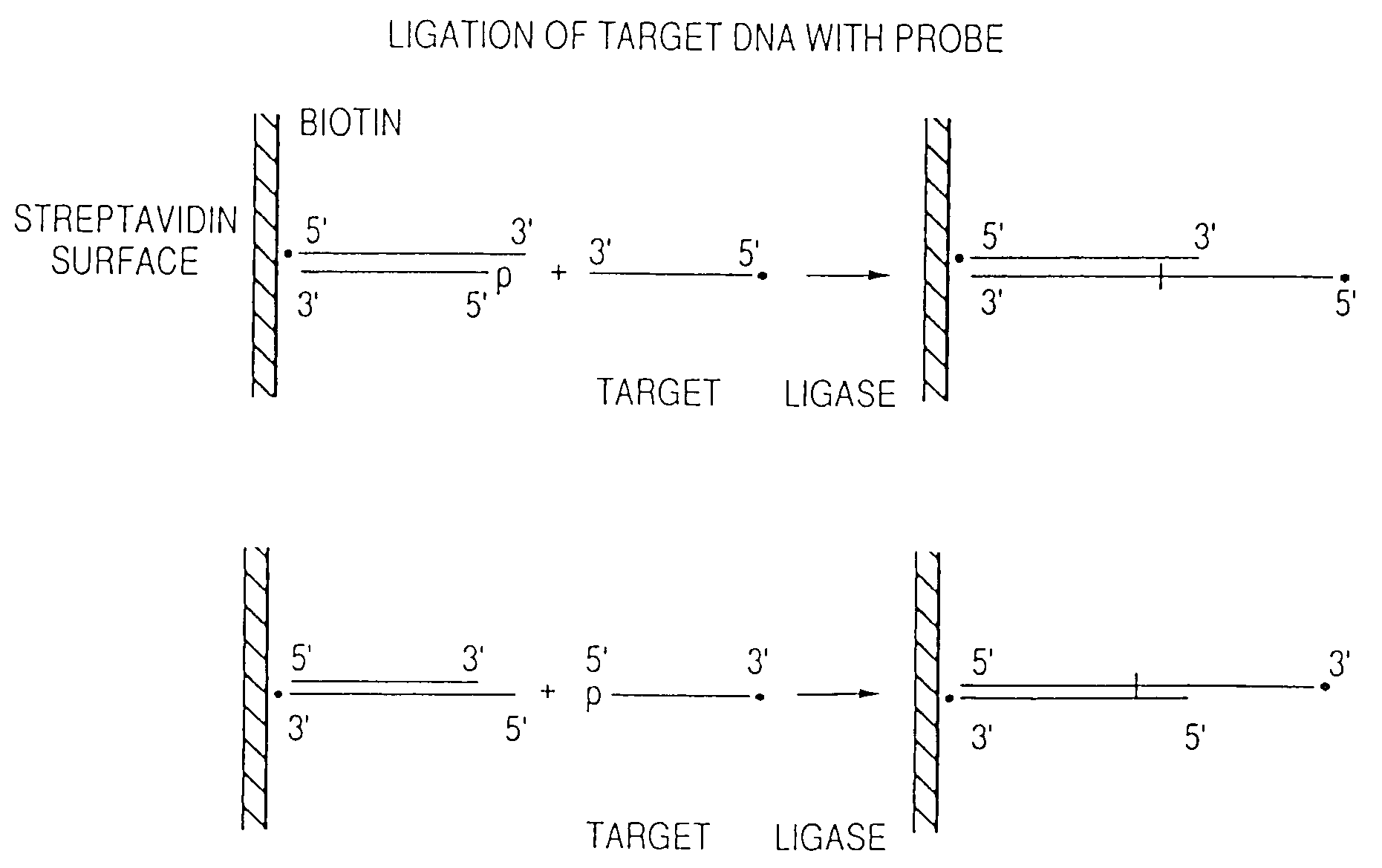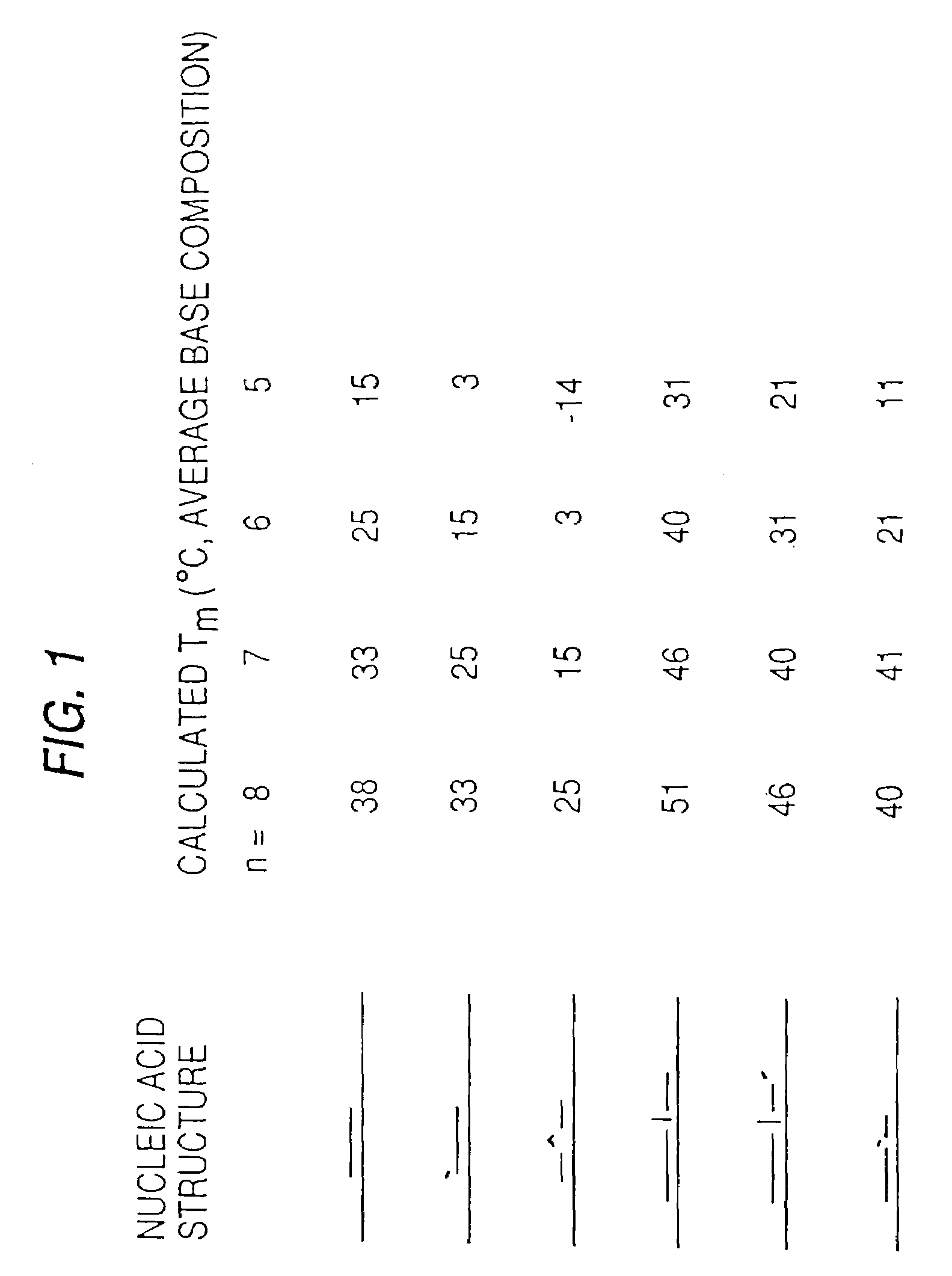Arrays of probes for positional sequencing by hybridization
a technology of positional hybridization and probe arrays, which is applied in the field of positional hybridization method for sequencing nucleic acids, can solve the problems of cumbersome and impractical procedures, inability to obtain sequence information directly from any other form of nucleic acid using either process, and inability to achieve the effect of rapid and accurate determination of the nucleotide sequence of a nucleic acid
- Summary
- Abstract
- Description
- Claims
- Application Information
AI Technical Summary
Benefits of technology
Problems solved by technology
Method used
Image
Examples
example 1
[0096]Manipulation of DNA in the solid state. Complexes between streptavidin (or avidin) and biotin represent the standard way in which much solid state DNA sequencing or other DNA manipulation is done, and one of the standard ways in which non-radioactive detection of DNA is carried out. Over the past few years streptavidin-biotin technology has expanded in several ways. Several years ago, the gene for streptavidin was cloned and sequenced (C. E. Argarana et al., Nuc. Acids Res. 14:1871, 1986). More recently, using the Studier T7 system, over-expression of the Protein in E. coli was achieved (T. Sano and C. R. Cantor, Proc. Natl. Acad. Sci. USA 87:142, 1990). In the last year, mutant streptavidins modified for improved solubility properties and firmer attachment to solid supports was also expressed (T. Sano and C. R. Cantor, Bio / Technology 9:1378–81, 1993). The most relevant of these is core streptavidin, (fully active protein with extraneous N- and C-terminal peptides removed) wit...
example 2
[0099]Terminal sequencing by positional hybridization. The basic sequencing by hybridization scheme is depicted in FIG. 2. It is different from any other because it uses a duplex oligonucleotide array with 3′-ended single-stranded overhangs. The duplex portion of each DNA shown is constant. Only the overhangs vary, and in principle an array of 4n probes is needed to represent all possible overhangs of length n. The advantage of such an array is that it provides enhanced sequence stringency in detecting the 5′ terminal nucleotide of the target DNA because of base stacking between the preformed DNA duplex and the newly formed duplex.
[0100]One variable is the length of the single-stranded overhang. The shorter the overhang, the smaller the array of probes potentially useable. Overhangs of five and six have been successfully employed. The nature of the support surface to which the oligonucleotide is attached, the means of its attachment, and the length of the oligonucleotide duplex are ...
example 3
[0103]Preparation of model arrays. Following the scheme shown in FIG. 2, in a single synthesis, all 1024 possible single-stranded probes with a constant 18 base stalk followed by a variable 5 base extension can be created. The 18 base extension is designed to contain two restriction enzyme cutting sites. Hga I generates a 5 base, 5′ overhang consisting of the variable bases N5. Not I generates a 4 base, 5′ overhang at the constant end of the oligonucleotide. The synthetic 23-mer mixture will be hybridized with a complementary 18-mer to form a duplex which can then be enzymatically extended to form all 1024, 23-mer duplexes. These can be cloned by, for example, blunt end ligation, into a plasmid which lacks Not I sites. Colonies containing the cloned 23-base insert can be selected. Each should be a clone of one unique sequence. DNA minipreps can be cut at the constant end of the stalk, filled in with biotinylated pyrimidines, then cut at the variable end of the stalk to generate the ...
PUM
| Property | Measurement | Unit |
|---|---|---|
| Efficiency | aaaaa | aaaaa |
| Efficiency | aaaaa | aaaaa |
| Efficiency | aaaaa | aaaaa |
Abstract
Description
Claims
Application Information
 Login to View More
Login to View More - R&D
- Intellectual Property
- Life Sciences
- Materials
- Tech Scout
- Unparalleled Data Quality
- Higher Quality Content
- 60% Fewer Hallucinations
Browse by: Latest US Patents, China's latest patents, Technical Efficacy Thesaurus, Application Domain, Technology Topic, Popular Technical Reports.
© 2025 PatSnap. All rights reserved.Legal|Privacy policy|Modern Slavery Act Transparency Statement|Sitemap|About US| Contact US: help@patsnap.com



